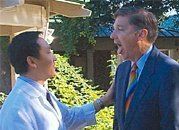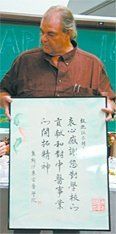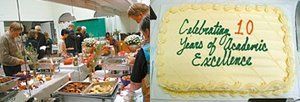Whether you accept it, avoid it or live somewhere in between, insurance coverage has become a defining issue for our profession. Patients increasingly expect to use their benefits, practitioners want to be compensated fairly for their time and expertise, and the system itself remains – at best – fragmented. The encouraging news is that coverage has expanded in meaningful ways. The challenging news is that reimbursement, across the board, remains inadequate.
The Academy of Oriental Medicine at Austin Turns 10: A Pictorial Perspective
When Stuart Watts and his wife, Annie, moved to Austin in the early 1990s, the creation of a new acupuncture school was not the first thing on his mind. Dr. Watts was already well-known in the acupuncture and Oriental medicine profession, having established two successful schools in New Mexico, and as a licensed acupuncturist, he was more interested in building his own practice than an institute of higher learning. When he saw the need for an acupuncture school in the area, however, the desire to create something where nothing existed became too strong to ignore, and in 1993, he started the Texas Acupuncture Institute (TAI), with an inaugural class of 18 students crammed into 3,135 square feet of office space. The school later changed its name to The Academy of Oriental Medicine at Austin (AOMA).

The early days of the institute's existence were not easy, either on Dr. Watts or the students. Because the school wasn't accredited by the Accreditation Commission for Acupuncture and Oriental Medicine (ACAOM), AOMA students were unable to obtain financial aid from the federal government to help pay for their education. As a result, the institute's dropout rate fluctuated from 30 percent to 35 percent the first few years it was in business.

All of that changed once the school earned academic recognition from ACAOM, gaining candidate status in May 95 and becoming fully accredited in November 1996. Accreditation brought with it the ability for students to receive federal financial aid. Today, the school's graduation rate hovers in the 95 percent range, and AOMA graduates pass the National Certification Commission for Acupuncture and Oriental Medicine's (NCCAOM) licensing exam at a rate consistently higher compared to the average pass rate of all applicants in the United States.
With accreditation came growth. Student enrollment grew at a 61 percent clip in the late 1990s, from 72 students in 1998 to 116 in 2000. During that same period, the number of faculty grew from 10 to 14, and the staff doubled. Today, AOMA has more than 200 students and occupies more than 12,000 feet of office space - nearly quadruple the size of the original TAI campus. The school even operates an herbal pharmacy and gift shop, which are often frequented by people who do not attend the academy.

As AOMA grew, so did its reputation among other schools in the acupuncture and Oriental medicine arena. In 2000, the Traditional Chinese Medicine World Foundation honored the academy as one of four schools that provided the best clinical training in the profession. In 2002, AOMA received the same honor from TCM World for its clinical training, and an additional honor for the quality of its faculty.
In October 2003, AOMA reached another milestone when it celebrated its 10th anniversary. In recognition of the occasion, and to commemorate the achievements the school has reached over the years, a variety of events were planned, including an alumni reunion and a special showing of a movie featuring an AOMA faculty member. The school also celebrated Acupuncture and Oriental Medicine Day, and Dr. Watts was recognized for his contributions to the school and the acupuncture and Oriental medicine profession.
Highlights of AOMA's 10-Year Anniversary
On Friday, Oct. 24, Austin Mayor Will Wynn appeared on the AOMA campus to proclaim the 24 as Acupuncture and Oriental Medicine Day. AOMA President Jim Coombes and Chief Academic Officer/Vice President Jamie Wu were on hand to accept the proclamation. During the ceremony, Mayor Wynn agreed to have Mr. Wu perform a tongue and pulse assessment on him. After examining the mayor thoroughly, Mr. Wu announced that Wynn had "very strong qi." Following Mayor Wynn's appearance, AOMA interns and faculty celebrated AOM Day by offering tongue and pulse assessments and herbal consultations to the public, free of charge.

On Sunday, Oct. 26, AOMA held an open house on campus. The public was invited to visit the academy and interact with AOMA alumni, students, faculty and staff. Patients, potential students and members of the general public participated in the festivities, which were highlighted by acupuncture, qigong and Asian bodywork demonstrations. The school also provided free treats and teas for attendees.
At 5 p.m. on the 26th, AOMA held a combination 10th anniversary party and alumni reunion, attended by dozens of former graduates. A large buffet-style dinner was held on campus, and Dr. Watts was presented with a hand-made scroll praising him for his dedication to the academy and Oriental medicine education. Several AOMA alumni and staff also shared stories about the academy's early days.

The reunion and party ended unofficially at 7 p.m. To conclude the festivities, from 7:30 to 9:30, the Alamo Draft House, a movie theater next door to the academy, held an exclusive showing of "The Honor of Dong Feng Xu," a feature-length action film starring Master Li Jun Feng, AOMA's dean of qigong. Before joining the academy, Master Li was best known as the head coach of the Beijing wushu (martial arts) team and national wushu team of the People's Republic of China, which won several national and international competitions. Master Li was on hand to talk about the making of the film, and discussed his early days as coach of the wushu teams.
The Academy of Oriental Medicine at Austin will host its annual Southwest Symposium in March 2004. For more information on the symposium, call (800) 824-9987, ext. 234, or visit www.aoma.edu.



